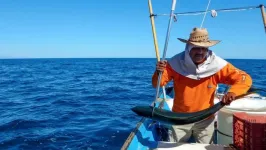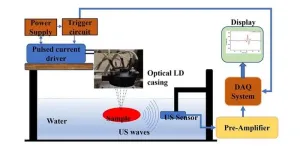(Press-News.org) Timothy Frawley has spent the better of the past two decades working in and around commercial fisheries. Born and raised in Casco Bay, Maine, he grew up packing lobsters and pitching bait on Portland’s working waterfront. He has worked in commercial fisheries in California, Alaska and the Mexican state of Baja California Sur.
Throughout his years spent on working waterfronts, Frawley, a postdoctoral researcher affiliated with the University of Maine’s Darling Marine Center, closely observed the ways in which fishermen conducted their business, making decisions about what and how they fished, and how it affected their operations and profit.
“While the desert of northwest Mexico and the rocky coast of Maine might seem to be worlds apart, I found surprising similarities between the coast of Baja and the coast of Maine,” Frawley reflected. “Both places include communities that are quite remote with local cultures and traditions defined by people’s strong and enduring connections to the ocean.”
With extensive knowledge of commercial fishing and observational and investigative skills he’s refined over the years, Frawley led an international team of researchers to determine how fishermen’s operational decisions affected their ability to adapt to climate change, a global force threatening their livelihoods.
In their new study published in the journal Global Environmental Change, researchers found that fishermen’s responses to a changing climate can be strongly influenced by how they fish and how they’re organized. The study highlights the role that distinct strategies associated with different group sizes and levels of cooperation play in how fishers respond and adapt to climate change.
“Climate variability and change in ocean ecosystems create challenges for fisheries’ sustainability, both economically and environmentally,” said Frawley, a postdoctoral researcher affiliated with the University of Maine Darling Marine Center. “While we know quite a bit about how individual fishermen and coastal fishing communities are responding to changing oceans, less is known about how the social structures through which they choose to organize themselves may influence their vulnerability to associated shocks and stressors and their capacity to adapt.”
Understanding factors that enhance fishers’ ability to adapt to environmental variability and change is critical. Coastal communities worldwide, including many fishing-dependent communities in Maine, are challenged by impacts of the climate crisis, including rising seas, reduced access to working waterfronts, shifting ranges of economically important species and rapidly changing technologies and economic conditions.
Frawley conducted this research while working as a postdoctoral research associate affiliated with the University of California Santa Cruz, NOAA’s Southwest Fisheries Science Center and UMaine. Together with collaborators at UMaine, Stanford University, Stockholm University, University of Rhode Island, Duke University, Oregon State University, Universidad Autónoma de Baja California, Sociedad de Historia Natural Niparajá, Scripps Institution of Oceanography and Comunidad y Biodiversidad (COBI), Frawley synthesized information on how and what people fish throughout northwest Mexico and how those behaviors shifted in the face of changing ocean conditions.
Some of these fishers belong to cooperatives, while others worked as independent owner-operators or as part of businesses backed by private capital from patrons. The regular “fish-tickets” through which fishers are required to report their harvests to the Mexican government provided the team an opportunity to examine how fishing strategies differed among business types before and after a series of marine heatwaves, and what it meant for the profitability of each.
The results indicate that while fishers working as part of cooperatives can be resilient to short-term environmental shocks, the narrow scope of the species they target may increase their vulnerability as climate change progresses. In many ways, small-scale cooperative fishers on the Pacific Coast of Baja California are becoming more and more like their counterparts in Maine and California. As other fisheries have faltered, the harvest of crustaceans such as lobster or Dungeness Crab is becoming increasingly dominant.
This study is part of MAREA+, a long-term interdisciplinary project focused on the environmental and human dimensions of small-scale fisheries in the Gulf of California region. The study was funded by the National Science Foundation and based on more than 10 years of fisheries data collected by fishermen and curated by the Mexican government.
Heather Leslie, a professor of marine sciences at the University of Maine based at the Darling Marine Center, mentored Frawley as part of this project.
“It is really exciting to see how fine-scale information on fishing organizations can illuminate our understanding of responses to climate impacts,” she observed. “It would be great to be able to do this type of analysis in New England, particularly given the growing interest in innovative approaches to fisheries, aquaculture and other dimensions of the blue economy.”
END
Business operations affect fishermen's resilience to climate change, new study finds
2024-02-13
ELSE PRESS RELEASES FROM THIS DATE:
Not too late to repair: gene therapy improves advanced heart failure in animal model
2024-02-13
Heart failure remains the leading cause of mortality in the U.S. During a heart attack blood stops flowing into the heart. Without oxygen, part of the heart muscle dies. The heart muscle does not regenerate, instead it replaces dead tissue with a scar made of cells called fibroblasts that do not help the heart pump. If there is too much scarring, the heart progressively enlarges, or dilates, weakens and eventually stops working.
“The current thought is that advanced or chronic heart failure, a stage in which the cardiac muscle has become too weak, is a point of no return. The present ...
Seeking a middle ground for reducing greenhouse emissions
2024-02-13
As the world gradually transitions to making meaningful reductions in greenhouse gas emissions, one of the most crucial questions that needs to be answered is how much that change is going to cost.
The United Nations Intergovernmental Panel on Climate Change (IPCC) has put out reports on this potential cost that showed global greenhouse gas emissions can be reduced by at least half in 2030 at a cost of less than $100 per ton of CO2 equivalent. A new study from the University of Delaware, Yale University and Columbia University, however, points out that these estimates do not consider some hidden, underlying frictions ...
New study finds no significant association between preterm delivery and autism
2024-02-13
UNDER EMBARGO UNTIL: Feb. 13, 2024, 3:00 PM EST
Media Contacts: Karen Addis, APR, karen@addispr.com, +1 (301) 787-2394; Kerri Wade, MPA, kwade@smfm.org, +1 (202) 236-1780
National Harbor, Md. -- Autism, also known as Autism Spectrum Disorder (ASD), is one of the most common developmental disorders and is increasingly diagnosed worldwide. According to the World Health Organization, an estimated one in 100 children has autism. In the U.S., those numbers are much higher, with an estimated one in 36 children being diagnosed with autism, according to the Centers for Disease Control and Prevention. Research into the causes of autism, specifically whether there is ...
Advancing biomedical diagnostics: Compact photoacoustic sensing instrument for breast tissue characterization
2024-02-13
In the realm of biomedical sciences, the quest for accurate and efficient diagnostic tools is ever-evolving. One such promising innovation making waves is the photoacoustic (PA) technique. In the past decade, PA imaging has emerged as a viable imaging modality demonstrated in many clinical applications with promising outcomes. Unlike traditional methods, PA offers a noninvasive approach to probing biological tissues, yet the technique has still been limited in wide clinical applications, partially due to bulky and expensive laser sources.
In a recent study published in the Journal of Biomedical Optics, researchers from the Indian Institute of Technology Indore ...
Updating allocation algorithms could help donor hearts reach the transplant patients who need them most
2024-02-13
Receiving a heart transplant is a matter of life and death for many patients. Every time a heart becomes available, a “match run” is created to generate a list of transplant candidates ranked by an algorithm based on medical urgency, geography and pediatric status. Unfortunately, deceased donor organs are very scarce in the United States – so much so that some patients aren’t even placed on waitlists because it’s too unlikely that a heart will become available to them.
A research team led by experts at the University of Chicago Medicine developed a new risk score designed to predict the likelihood that ...
New study reveals dynamic impact of nicotine on brain regions responsible for reward and aversion
2024-02-13
HUNTINGTON, W.Va. – A new study led by researchers at the Marshall University Joan C. Edwards School of Medicine sheds light on the intricate interplay of brain regions involved in nicotine's effects on the human brain.
The research, published in eNeuro, an open-access, peer-reviewed scientific journal published by the Society for Neuroscience, explores how nicotine influences key areas associated with reward and aversion, showcasing a nuanced relationship that varies based on dosage, sex and distinct brain regions. The medial ...
New assay identifies clinically relevant gene fusions in pediatric tumors more accurately and efficiently
2024-02-13
Philadelphia, February 13, 2024 – Identification of specific gene fusions is critical for the successful targeted treatment of pediatric cancer patients. Researchers at Children’s Hospital Los Angeles have developed a novel assay that automatically integrates the data from multiple fusion identification tools (callers) and efficiently and accurately identifies clinically relevant gene fusions in pediatric tumors. Their results are reported in The Journal of Molecular Diagnostics, published by ...
Pediatric sickle cell disease team uses pain screening to improve care
2024-02-13
CLEVELAND -- A recent study from researchers at University Hospitals (UH) Connor Whole Health and UH Rainbow Babies & Children’s Hospital describes a quality improvement project where pain screening procedures were embedded within an outpatient pediatric sickle cell disease (SCD) clinic. The study examined (1) the feasibility of routine pain screening, (2) the prevalence of various clinical pain presentations, and (3) what integrative health and medicine modalities were preferred by youth aged 8 to 18 with SCD.
The study, entitled “Pain Screening in Youth with Sickle Cell Disease: A Quality Improvement ...
Grantees selected for The Mark Foundation for Cancer Research and the Samuel Waxman Cancer Research Foundation Aging and Cancer Initiative
2024-02-13
New York, NY – February 13, 2024 – The Mark Foundation for Cancer Research and the Samuel Waxman Cancer Research Foundation (SWCRF) have selected six investigators to receive three grants for their collaborative, two-year program aimed at improving our understanding of the links between aging and cancer. With additional support from the Melanoma Research Alliance (MRA), $1.5 million will fund three innovative projects, each pairing one lab focused on aging with another working on cancer research.
Aging is a major risk factor for developing and dying of cancer. In fact, 90 percent of cancer diagnoses and deaths occur in people ...
Benefits of heat pumps detailed in new NREL report
2024-02-13
Millions of U.S. households would benefit from heat pumps, but the cost of installing the technology needs to come down to make their use a more attractive proposition, according to researchers at the U.S. Department of Energy’s National Renewable Energy Laboratory (NREL).
The findings, detailed in the journal Joule, quantify the costs and benefits of air-source heat pumps across the United States and consider various climates, heating sources, and types of homes. The researchers based their conclusions on simulations of 550,000 statistically ...





